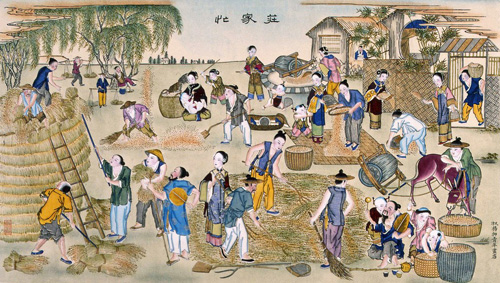Culture preserved in New Year’s woodblock paintings

A New Year's woodblock painting shows local people’s working scenes and daily life.
Rapid economic development is threatening the sustainability of New Year’s woodblock paintings. The traditional art form has existed for thousands of years and involves attaching a woodblock painting to people’s front doors. The art form utilizes complicated techniques but in many cases these techniques are not being passed down. In recent years, the significance of this intangible cultural heritage has been realized, and measures to preserve the art are being explored.
Origin, development
A thousand years ago, New Year’s woodblock paintings emerged in Zhuxianzhen, Henan Province, and the art form developed rapidly. Their influence was quickly transmitted to the whole nation and evolved into different styles of New Year’s woodblock paintings with local characteristics.
The Yangjiabu New Year’s style of painting highlights the wild, frontier aspects of people’s lives in Northern China and the Taohuawu New Year’s style of painting presents the southern people’s gentle personalities.
The Zhuxianzhen New Year’s style of painting shows elegance, while the Yangliuqing New Year’s style of painting uses a rich, colorful style. Ingenious craftsmen utilized New Year’s woodblock paintings to showcase their aesthetic tastes and values. By appreciating colorful New Year’s woodblock paintings, people can feel the significance of history and the charm of culture, realizing ancient Chinese people’s ideal of having a “poetic dwelling” and understanding Chinese people’s pursuit of happiness, prosperity and reunions.
New Year’s woodblock paintings originated from prehistoric religion, and were incubated during the process of high development in the Han (206 BC-AD 220) and Tang (618-907) dynasties. They further developed in the Northern Song Dynasty (960-1127) on the basis of prosperous urban life.
During the Song Dynasty (960-1279), the woodblock printing technique matured and costs to produce it were significantly reduced. This achieved real popularization of New Year’s woodblock paintings among ordinary people. Craftsmen in the Song Dynasty applied the woodblock printing technique to duplicating and printing paintings of gods and auspicious images, which made it possible for ordinary people to buy these paintings, paste them on their doors before the Chinese New Year’s eve, and pray for happiness in the next coming year.
During the Song Dynasty, the market of New Year’s woodblock paintings had become well established and reached a considerable size in the capital. More and more people pasted New Year’s woodblock paintings on their front doors. Later, craftsmen’s workshops expanded their businesses from the capital to surrounding areas, even the whole nation. After the middle period of the Ming Dynasty (1368-1644), there emerged a number of production areas of New Year’s woodblock paintings. In the late Qing Dynasty (1616-1911), the production of New Year’s woodblock paintings reached a peak and thousands of paintings decorated ordinary people’s homes.
Artistic, research value
As the times change, the primary function and status of New Year’s woodblock paintings have gradually faded away. In the view of contemporary civilization, the value of New Year’s woodblock paintings is reflected in two aspects: First, they have research value. An abundance of ancient New Year’s woodblock paintings have been preserved and are precious resources that offer a window into Chinese folk historical and cultural ideology in ancient times. Second, they have artistic value. Although its utility function has gradually diminished, the transmission of New Year’s woodblock paintings has encouraged folk artists and craftsmen in different areas to form their own unique drawing skills and styles, which is still a significant artistic resource.
Foreign scholars worked on studies of Chinese New Year’s woodblock paintings much earlier than domestic scholars. Russian botanist Vladimir Leontyevich Komarov (1869-1945), Russian Sinologist Vasiliy Alekseyev (1881-1951) and Boris Lyvovich Riftin (1932- ) all studied Chinese folk New Year’s woodblock paintings from the perspective of an “exotic country and exotic culture.” They regard these paintings as a unique and attractive artistic form. Their research also delved into such areas as psychology and cultural preferences.
Since the early 1920s, many Chinese scholars in literary and artistic circles, including Lu Xun (1881-1936) and Zheng Zhenduo (1898-1958), began to study ancient Chinese New Year woodblock paintings. By the early 1950s, people’s passion for New Year’s woodblock paintings had faded. But Wang Shucun (1923-2009), Bo Songnian (1932- ) and other art historians investigated and protected the ancient New Year’s woodblock paintings, preserving this cultural heritage.
In recent years, with the promotion of intangible heritage protection projects in China, people have gradually realized the significance of studies into traditional culture and regional culture. So researchers of sociology, anthropology, folklore and art lead a new research wave into New Year woodblock paintings.
Zhang Qingli is a reporter at the Chinese Social Sciences Today.
